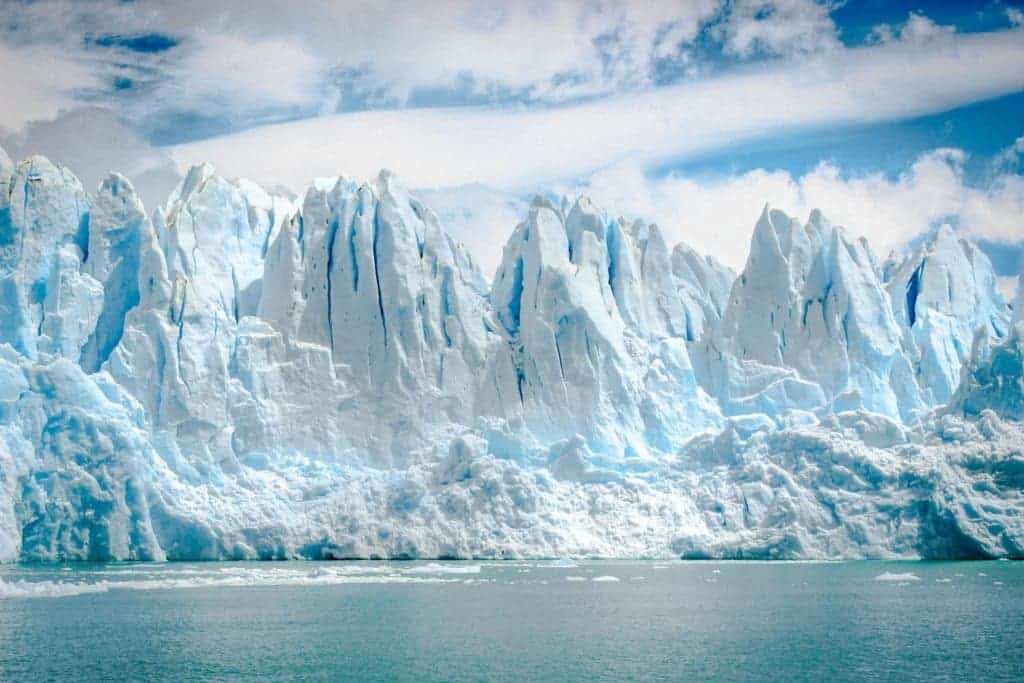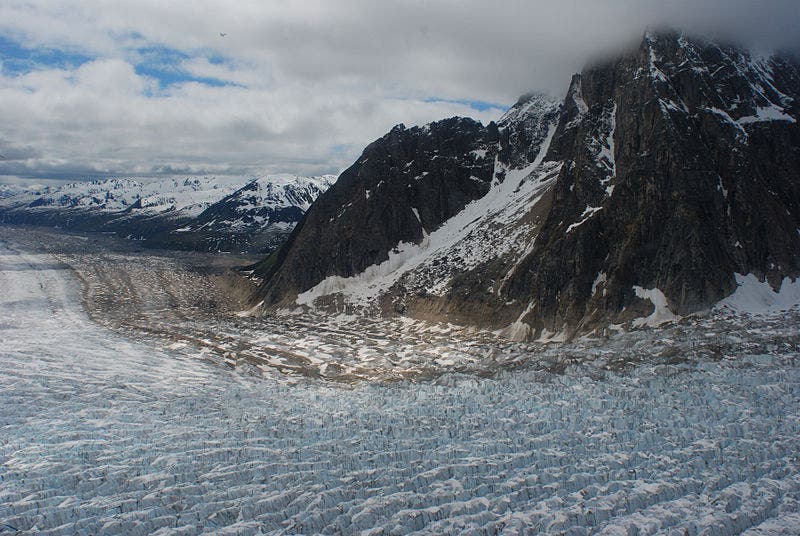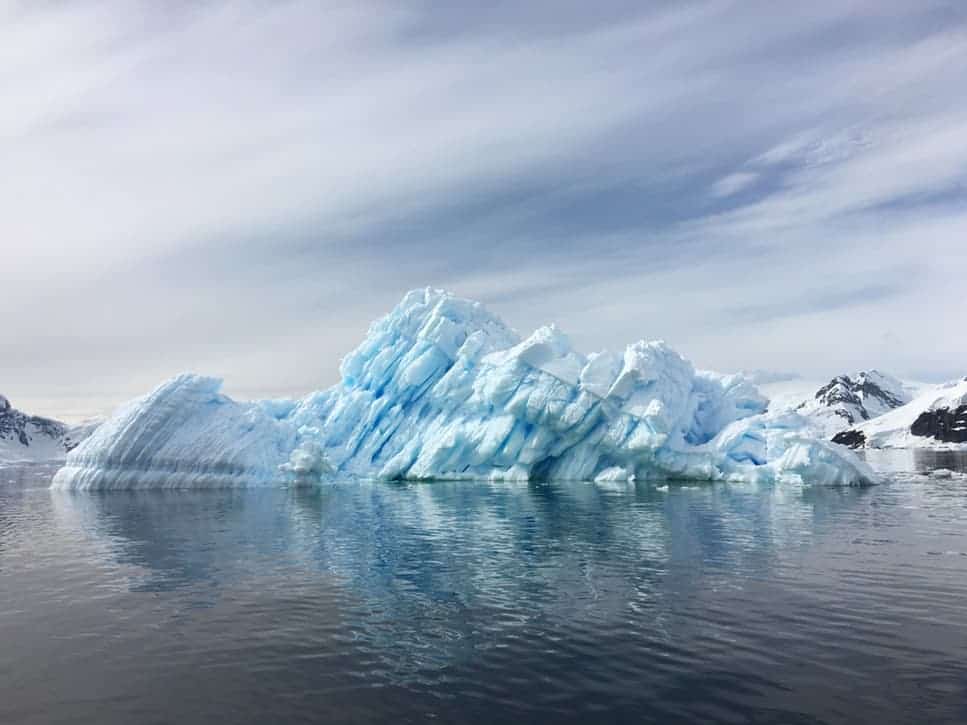Think of glaciers as rivers of ice that form and flow in the coldest and most mountainous regions of our planet including the Antarctic (south pole), Greenland, and Alaska. They move very slowly compared to liquid rivers but are much larger and thus contain and influence a tremendous amount of the water on Earth.
They are also canaries in the coal mine that is global warming.

Not too long ago, I visited Alaska and got up close to a number of glaciers. They are truly awe-inspiring in their beauty and scale, but they also hold some concerning signs about the changing climate.
During my travel I was a bit surprised to see two distinct types of glaciers; those that are ‘landlocked’ and those that flow into the sea.
Mountain glaciers flow from high mountains through valleys and can end up melting into the ground. There are many of these glaciers in the Alaska Mountain range, in Denali National Park. I had the opportunity to take a ‘flightseeing’ trip in an 8-seater plane from the town of Talkeetna to tour the area around Ruth and Kahiltna glaciers. It was a fantastic way to see these natural wonders.
I learned that as these glaciers flow they scrub the mountainsides, enveloping and moving tons of rocks along the way. The rocky debris, called till, ranges in size from fine silt to boulders the size of houses and is carried along and deposited at the end of a landlocked glacier in large piles called terminal moraines. As a result, it is not obvious to the untrained eye just where a mountain glacier ends. They are so laden with debris they just appear to be rocks or earth; picture the edge of a pile of snow left in the corner of the parking lot in early spring, with dirt and cinders covering it. Ruth glacier even has trees growing on it.

Glaciers that flow into a body of water, aka “tidewater” glaciers, are common in southeast Alaska (near Juneau). These tend to be more visually interesting because the terminus of the glacier is hundreds of feet tall and is beautifully colored with a stunning mix of bright blues and whites. They often contain black and brown stripes from medial moraines, which are created when two glaciers merge (like streams flowing into a river).
This high wall of ice at the terminus is called the “calving front” because chunks of ice often fall off or “calve” into the water. Tidewater glaciers generally extend deep below the water’s surface as well, and when a mass of underwater ice calves the result can be dramatic. While observing Dawe’s glacier from a small skiff with our guide, I noticed rough water at the base of the calving front, and within seconds several huge pieces of ice shot high out of the water before splashing down into the fjord. That major calving event created a wave that moved towards us, prompting our guide to turn the skiff around and get us to a safe distance.
The ice sheet or ice field can be thought of as the ‘lake’ or ‘reservoir’ of ice and the glaciers are the rivers and streams flowing out of them. Like reservoirs, ice fields are filled by precipitation and to maintain a constant level there needs to be a balance of water coming in (snow) and water flowing out (glaciers).
Curious to learn more, I read “The Ice at the End of the World” by Jon Gertner. In it, the author brings to life the history of exploration of Greenland’s ice sheet and how the goals evolved from conquering unknown territory to gaining scientific knowledge.
The early pioneering spirit and desire to explore one of the last frontiers on Earth drove many men to endure long, unbearably cold treks across the ice sheet around the turn of the 20th century.
Scientific exploration of the Greenland ice sheet began in earnest in the mid-20th century with drilling of ice cores deep into the sheet, all the way to bedrock. Their efforts to extract and analyze thousands of
feet of compact snow and ice has yielded an amazing record of annual climate conditions dating back hundreds of thousands of years.

Twenty-first century research methods utilize planes equipped with sophisticated instrumentation to map the ice sheet as well as what lies beneath it in Greenland as well as Antarctica and Alaska. NASA has been directing most of this recent work as part of Operation Icebridge. Gertner’s book reveals how much all of these scientific studies have contributed to our understanding of our planet’s climatic history, and how knowing this has enabled climatologists to detect and measure the global warming that is occurring now.
The evidence of global warming is stark: most glaciers are losing volume and depth, and there is significantly less ice cover in the polar regions compared to years past. The big risk is that they will lose so much mass that a positive feedback loop ensues, accelerating the loss of ice and inducing significant rises in sea level. At this point we have only the technology to monitor the situation and no way to stop it.
Hopefully, as we learn more, scientists and engineers will find a way to slow this process. Operation IceBridge completed most of its flying missions in early 2020 and analysis is ongoing. Check out the numerous news articles written in 2019 and 2020 to get the latest information on the dynamic situation of these frozen reservoirs.
If you’ve enjoyed this article, here is a list of supplementary reading to keep you going:
- “The Ice at the End of the World”; book by Jon Gertner; ISBN 9780812996623. Fascinating history of exploration of the Greenland ice sheet from the late 1800’s through 2018.
- Glacier Bay National Park Website.
- Operation IceBridge web site.
- “Chasing Ice”; film starring James Balog. Award-winning documentary about Jim’s efforts to capture the dynamics of glaciers through photography. Gorgeous imagery and fascinating results. See also his TED talk!






